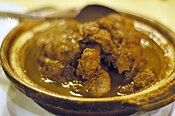Macanese cuisine
| Part of a series on the |
| Culture of Macau |
|---|
 |
| History |
| Languages |
| Cuisine |
| Religion |
| Sport |
Macanese cuisine (Chinese: 澳門土生葡菜, Portuguese: culinária macaense) is mainly influenced by Chinese cuisine, especially Cantonese cuisine and European cuisine, especially Portuguese cuisine and influences from Southeast Asia and the Lusophone world, due to Macau's past as a Portuguese colony and long history of being an international tourist gambling centre.
It is an early example of a fusion cuisine and dates to the 16th century.[1]
Dishes
[edit]Minchi, egg tarts, pork chop buns, ginger milk and almond cakes are some of the region's most common delicacies. Common cooking methods make use of various spices such as turmeric, coconut milk, and cinnamon to give dishes an extra kick of aroma and enhancement of taste. Many routinely consumed dishes in Macau belong to a subclass (Heungshan) of Cantonese cuisine. Many Macanese dishes resulted from the spice blends that the wives of Portuguese sailors used in an attempt to replicate European dishes with local Chinese ingredients and seasonings.
Typically, Macanese food is seasoned with various spices including turmeric, coconut milk, and cinnamon, and dried cod (bacalhau), giving special aromas and tastes. Popular dishes include galinha à Portuguesa, galinha à Africana (African chicken), bacalhau (traditional Portuguese salt cod), pato de cabidela, Macanese chili shrimps, minchi,[2][3][4] stir-fried curry crab; pig's ear and papaya salad, and rabbit stewed in wine, cinnamon and star anise.
Cha Gordo
[edit]Cha Gordo (literally "Fat Tea"[5]) is a culinary tradition amongst the Macanese community in Macau that is likened to afternoon tea.[5] Historically, families with Portuguese heritage in Macau would host a Cha Gordo for a number of occasions, including Catholic holidays, christening, or birthdays, but they can be held for any reason.[6] Historically, some families would even host one on a weekly basis.[5] A Cha Gordo would take place following a Macanese wedding, instead of the elaborate banquet seen in Chinese weddings.[7]
Macanese dishes and desserts
[edit]-
Galinha à Africana
-
Galinha à Portuguesa
-
Pastéis de nata
-
Pato de cabidela
Non-Macanese Macau snacks
[edit]-
Pork chop bun
-
Apricot kernel biscuit
-
The Macau ginger milk curd resembles this Hong Kong ginger milk curd.
See also
[edit]Select bibliography
[edit]- Ferreira Lamas, João António (1995). A culinária dos macaenses. Oporto: Lello & Irmão.
- Gomes, Maria Margarida (1984). A cozinha macaense. Macau: Imprensa Nacional.
- Senna, Maria Celestina de Mello e (1998). Cozinha de Macau. Lisbon: Vega ISBN 972-699-575-2
References
[edit]- ^ Keegan, Matthew (14 January 2019). "Macau's rare fusion cuisine". BBC. Retrieved 25 April 2024.
- ^ Peres, Sara (4 November 2007). "De faca e garfo: Um "minchi" de dupla nacionalidade". Jornal Tribuna de Macau (in Portuguese). Archived from the original on 2 October 2011. Retrieved 22 June 2010.
- ^ "The page cannot be found" (PDF). Archived from the original (PDF) on 29 May 2010. Retrieved 22 June 2010.
- ^ "Gastronomia". Direcção dos Serviços de Turismo (in Portuguese). Archived from the original on 30 June 2012. Retrieved 22 June 2010.
- ^ a b c Cummings-Yeates, Rosalind (18 August 2015). "Feasting on Fat Tea in Macau". TravelPulse.
- ^ Loh, Juliana (10 April 2015). "Cha Gordo: Macau's ' fat tea' a celebration of Macanese cuisine and culture". South China Morning Post. Retrieved 7 March 2018.
- ^ Daniels, Maggie; Loveless, Carrie (2014). Wedding Planning and Management: Consultancy for Diverse Clients (Second ed.). Routledge. p. 29. ISBN 9781136160554.








